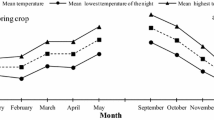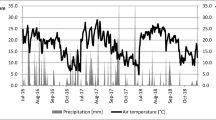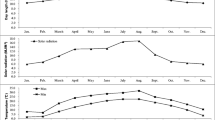Summary
Length of dormancy limits the use of autumn-grown seed potatoes for planting the spring crop. Trials of different treatments for breaking dormancy were carried out for four successive seasons (1958–1961).
Cutting the seed and dipping in gibberellic acid (GA) was effective in breaking dormancy. Cutting two weeks before planting and dipping the seed pieces in a 1 ppm GA solution gave the best results. Instead of cutting, smaller sized seed can be pierced, thus enabling the entire yield of tubers to be used for seed.
Higher concentrations of GA induced growth abnormalities in both plants and tubers without producing any improvement in the breaking of dormancy over the lowest concentration used (1 ppm). Physiological aspects of seed potatoes are discussed.
Zusammenfassung
In Israel wird der Gebrauch von Saatkartoffeln aus Herbsternte für die Frühjahrspflanzung durch die Länge der Keimruhe beschränkt. Während vier aufeinanderfolgenden Anbauperioden (1959–1961) wurden Versuche mit verschiedenen Behandlungen zur Brechung der Keimruhe durchgeführt.
Durch Schneiden und Eintauchen der Saatknollen in Gibberellinsäure (GA) wurde die Keimruhe wirksam gebrochen. Die besten Ergebnisse wurden erzielt, wenn das Saatgut zwei Wochen vor der Pflanzung geschnitten und die Knollenstücke in eine GA-Lösung von 1 ppm eingetaucht wurden (Tabellen 1 und 2). Kleinere Saatknollen können statt geschnitten nur durchstochen werden, so dass der ganze Knollenertrag für Saatzwecke gebraucht werden kann (Tabelle 2). Höhere GA-Konzentrationen führten zu Missbildungen sowohl der Pflanzen wie der Knollen, ohne eine Verbesserung im Brechen der Keimruhe gegenüber der niedrigsten angewendeten Konzentration (1 ppm) zu bewirken. Physiologische Aspekte der Pflanzkartoffeln werden besprochen.
Résumé
En Israël, la longueur de la dormance limite l’utilisation de plants de pomme de terre poussés en automne pour la plantation de printemps. Différents traitements pour rompre la dormance ont été effectués pendant quatre saisons successives (1959–1961).
Le sectionnement des plants et le trempage dans l’acide giberellique (GA) sont efficaces pour rompre la dormance. Le sectionnement deux semaines avant la plantation et le trempage des fragments dans une solution à 1 ppm1 de GA donnent les meilleurs résultats (Tableaux 1 et 2). Les petits plants peuvent être perforés plutôt que sectionnés, ce qui permet alors d’utiliser la récolte entière de tubercules comme plants (Tableau 2).
Une plus haute concentration de GA provoquait le développement d’anomalies à la fois dans les plantes et les tubercules sans apporter d’avantage dans la rupture de la dormance, par rapport à la plus basse concentration utilisée (1 ppm1). Le point de vue physiologique est discuté.
1ppm.=partie par million.
Similar content being viewed by others
References
Ashbel, D. (1950): Bio-climatic Atlas of Israel. Hebrew Univ. Jerusalem. p. 95.
Doorenbos, J. (1958): Effect of gibberellic acid on sprouting potatoes.Neth. J. agric. Sci. 6, 257–270.
Lippert, L. F., L. Rappaport andH. Timm (1958a): Systemic induction of sprouting in white potatoes by foliar applications of Gibberellin.Plant Physiol. 33, 132–133.
—,L. Rappaport andH. Timm (1958b): Sprouting, plant growth and tuber production as affected by chemical treatment of white potato seed pieces. Breaking the rest period with gibberellic acid.Am. Potato J. 34, 254–260.
Littauer, F. (1944):Sclerotium bataticola Taub. on potatoes in Palestine.Palest. J. Bot. Rehovot. 4, 142–147.
Matkur, P. B. (1961): Reversal of X-Ray-induced dormancy of potato tubers by gibberellic acid.Nature, Lond. 190, 547.
Rappaport, L. (1956): Growth regulating metabolites.Calif. Agric. 10, 4–11.
Slomnicki, I. (1961a): Screening potato varieties for short dormancy.Eur. Potato J. 4, 201–210.
— (1961b): Problems of potato breeding in Israel.Eur. Potato J. 4, 394–399.
Slomnicki, I. andD. Linnell (1958): Trials with Israeli autumn-grown seed potatoes in Sweden (Unpubl.).
Tsukamoto, Y. (1958): Present state of Gibberellin studies in Japan.Proc. 15th Int. hort. Congr. 1, 42–47.
—,T. Asahira andT. Namiki (1961): Studies on the dormancy of the potato tuber. IV. The effect of Gibberellin on breaking dormancy of potatoes lifted at different times.Mem. Res. Inst. Fd. Sci. Kyoto Univ. No. 23, 23–27.
—,K. Kako andT. Namiki (1960): Studies on the dormancy of the potato tuber. III. Differences of potato yields in fall crop by the treatment of Gibberellin.Bull. Res. Inst. Fd. Sci. Kyoto Univ. No. 25, 7–15.
Author information
Authors and Affiliations
Additional information
Publication of the National and University Institute of Agriculture, Rehovot, Israel. 1963 series. No. 571-E.
Rights and permissions
About this article
Cite this article
Slomnicki, I., Rylski, I. Effect of cutting and gibberellin treatment on autumn-grown seed potatoes for spring planting. Europ. Potato J. 7, 184–192 (1964). https://doi.org/10.1007/BF02368155
Received:
Issue Date:
DOI: https://doi.org/10.1007/BF02368155




